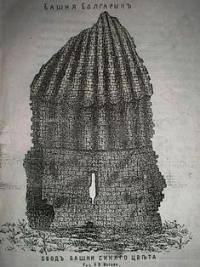Вы здесь
Balgasyn mausoleum.

Tours in Kazakhstan for extreme.
“The beautiful tower, covered as if with turquoise, amid the monotonous, loose sands, makes a strong impression. It is visible fifteen miles away."
A. Matov.
Tourist trips across Kazakhstan.
The Balgasyn mausoleum was located on the Bolgasynmola necropolis, 185 meters on the left (western) bank of the Bolgasyn stream, 6.2 kilometers south-west of Lake Tebez, 11.6 kilometers south-west of the Taldykum village, 35.5 kilometers to the north of the administrative center of the Shalkar region - the Shalkar village in the southeastern part of the Aktobe region.
The only building of this kind in the vicinity was the Balgasyn mausoleum, a description of which was left by A. Matov.
In a short newspaper annotation, he notes: “A beautiful tower, covered like turquoise, amid monotonous, free-flowing sands, makes a strong impression. It is visible fifteen miles away." The figure accompanying the publication shows a dilapidated building with a ribbed dome on a faceted drum. He, in addition, notes:
“The tower was erected on a foundation of amazingly strong red brick. The northern side of the ruin is 13 steps in length, the eastern side before the collapse is 10 steps; it must be assumed that the tower was at least 20 paces long. The outer part of the dome is lined with fine glazed bricks.
The tower was 10 fathoms high. Its southern part collapsed...”, that is, at the end of the XIXth century, the Balgasyn mausoleum was already in a dilapidated state. Ten years later, this area was visited by the famous researcher of the Kazakh steps, I. Kastanier, and saw at the place that he was shown only a heap of bricks, which had formed at the site of the destruction of the mausoleum.
It can be concluded that the complete collapse of the mausoleum took place between 1897 and 1907, i.e. during the period between his visits by A. Matov and I. Castanier. The bricks from the mausoleum were used mainly for the construction of furnaces, and fragments of glazed tiles were placed in later burials.
This folk tradition, destructive for monuments of medieval architecture, was widespread in many regions of Kazakhstan. It was constantly recorded by I. Kastanier, the first researcher of burial structures in the Kazakh steppes.
When visiting the Sygnak settlement and the Sunakata mazar, he saw that several argali horns and "pieces of a well-preserved tile" were laid on the tombstone covered with a white veil. At the same time, he notes that among the Kazakhs it was common to put on the grave of their loved ones pieces of tiles or bricks, which they extracted, naturally, from the nearest especially revered mausoleums.
This circumstance, obviously, was one of the factors that made the ancient memorial and other religious buildings in the Kazakh steppes into a deplorable state. A large number of bricks from the monument were obviously used during the construction of the Onalbek-ata mausoleum at the end of the 19th century.
It is visible to the naked eye that the upper part of the drum and the dome of the monument are made of reused bricks, which could have been from the Balgasyn mausoleum, and these are several thousand bricks.
Geographic coordinates of the Bolgasynmola necropolis on which the Bolgasyn mausoleum was located: N48 ° 09'43.12 "E59 ° 38'09.88"
Authority:
E.A. Smagulov, A. Bermagambetov. "Archaeological exploration in the Shalkar district of the Aktobe region."







